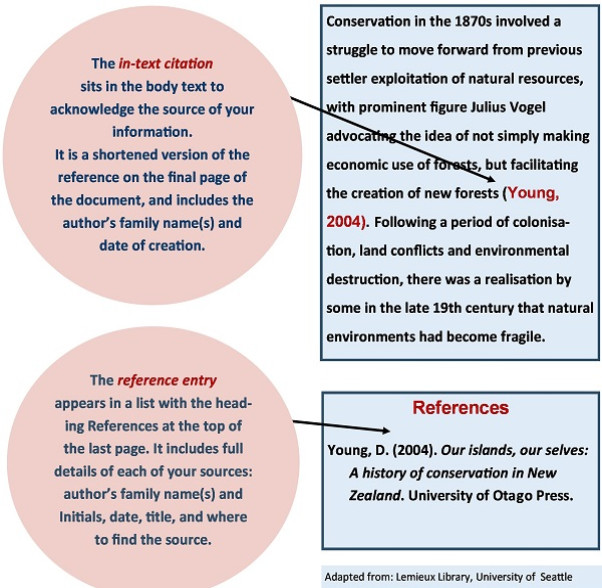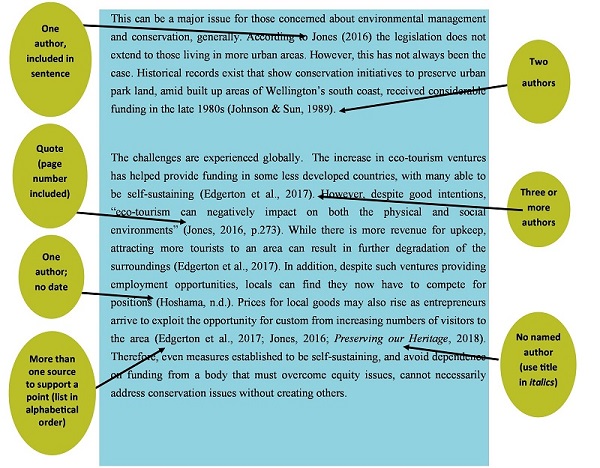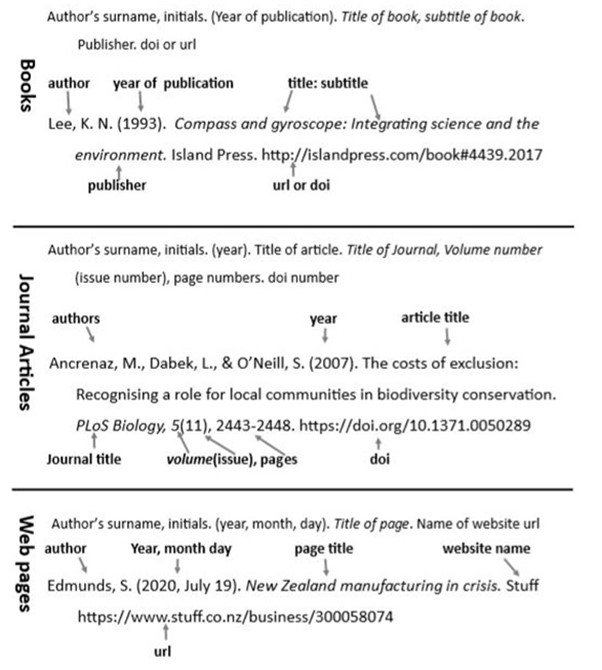Referencing
Advice on referencing and the APA style used in most courses here at Lincoln University.

This page covers both the why, when and how of referencing in your academic work based on the APA style used in most courses here at Lincoln University. You may also want to review our advice on Copyright and our page on using Paraphrases, summaries and quotes. You may also want to use a tool such as EndNote.
The APA 7th style guide is a 'how to' guide on referencing common material including journal articles, websites, lectures and lecture slides, and social media.
Referencing is very important to your success at university. It is a vital academic skill and you have to get your head around it. Referencing well will improve the quality of your work and get you higher marks.
Reference to:
| Show your argument is supported by evidence | Acknowledge you have used the words or ideas of another person | Allow readers to find the original source of your information |
|
Shows you have read widely to develop your ideas |
Gives credit where it is due | Allows the readers to assess the validity and reliability of the evidence |
| Shows your ideas are supported by the work of others | Avoids plagiarism (claiming someone else's work as yours) | Allows the reader to find more detail for themselves |
All academic writing draws on the ideas and findings of other researchers and writers. Whenever you use an idea, image or section of text that you found somewhere else, you need to make it clear where that information came from. Check out our information on Using Sources, and if in doubt reference!
| You must reference when you: | You usually don't reference when you: | |
| Quote exact words | Use your own knowledge (eg personal experience, your own experimental data) | |
| Paraphrase or summarise (refer to or use someone else's ideas in your words) | Refer to common knowledge (eg the Treaty of Waitangi was signed in 1840) | |
| Use factual data from other sources (eg statistics) | Use general subject knowledge in your own words | |
| Reproduce a chart, image or diagram | ||
| Want to show you have evidence for a statement or argument you are making |
Referencing always has two parts: an in-text citation and a reference:

For more detailed tips, check out our resource on how to smoothly include and cite summaries, paraphrases and quotes in your writing.
|
This tells the reader where you found the information you have used in your writing.
|
The reference list entry: This tells the reader where they can find the information you have used in your writing.
|

Here’s an example of referencing different types of sources in a piece of writing. (Note the punctuation)
At the end of the piece of writing, there is a list of all the sources used. Here is how to write reference list entries for the three most common types of source. (Note carefully the punctuation.)

It is critical to correctly capitalise your reference entries. In many cases you will need to correct the capitalisation, as the source of the work will not use correct capitalisation.
When entering titles we may need to use either title case, sentence case, or use the title and subtitle, depending on the specifics of the work you are referencing.
Original Title on the website. STRANDED AT THE TOP OF THE HIMALAYAS—DISASTER ON MT EVEREST
Title Case: capitalise the first word and all other words except connective words like “in, of, it, and, the”.
Stranded at the Top of the Himalayas—Disaster on Mt Everest
Sentence Case: capitalise the first word and also proper nouns such as the names of people, places, organisations and species. All other words are lower case.
Stranded at the top of the Himalayas—disaster on Mt Everest
Titles with Subtitles: separate the title and subtitle using a colon : the subtitle is capitalised as a new
sentence.
Stranded at the top of the Himalayas: Disaster on Mt Everest
Author names
Always capitalise authors exactly as written, even if it does not conform to standard English conventions or includes non-standard characters.
E.g. “de Villiers”, “InfoTECH”, or “!Kung ” are always written this way in the reference list and citation.
Names are always written as: Family name, Initials. E.g. Sarah Louise Taylor is written as Taylor, S. L.
Titles such as Doctor, Professor, Sir, Dame, PhD, DSO etc. are never included in the name entry.
If you cannot determine which is the family name the following general rules can help:
- If the name is written as several names in a row, the final name is usually the family name.
E.g. Winston Eugene Roland McDairmand becomes McDairmand, W. E. R. - If the name is written with a comma in it, the name(s) preceding the comma is the family name.
E.g. De Reuyter, Marcella Patricia becomes De Reuyter, M. P.
We recommend that undergraduates use the following series of steps when including an image in your document.
- Insert the image into your document
- Above or below the image place a figure number, assigned in order from the start of the document; e.g. Figure 1:, Figure 2: …
- Next to the figure number give the title of the image; e.g. Figure 3: Wainoni landscape
- Directly below the image add explanatory notes or description, including the citation and any creative commons licence information needed. If the creator of the photo is different from the author in the reference list, give both names using the “Citing a Source within another source” rule in the APA guide
- In your reference list create a reference entry for your image.
- When discussing the image in the body of the text, refer to it by the figure number.
Example: – in text
Figure 7: Ship Portrait – “USS Texas”

When discussed in text
In Figure 7 we can see a classic example of large scale war memorials, which are common throughout the United States.
In the reference list
Vest, L. (2006, November 18). Ship portrait – “USS Texas”. Flickr. https://flic.kr/p/t5LyL
Whether to add information to a new study or illustrating why a course of research wasn’t taken through citing negative research data, using data from another researcher’s study is becoming more commonplace. Lincoln University uses APA style.
|
For datasets with a DOI (digital object identifier): Author/Rightsholder. (Year). Title of data set (Version number) [Description of form]. doi:10.###/### Skinner, E.-T. & Fitchett, D. (2013). Basic data management practices. doi:10.6084/m9.figshare.781296 |
|
For datasets without a DOI: Author/Rightsholder. (Year). Title of data set (Version number) [Description of form]. Retrieved from URL Pew Hispanic Center. (2004). Changing channels and crisscrossing cultures: A survey of Latinos on the news media [Data files and code book]. Retrieved from http://pewhispanic.org/datasets |
|
For purchased datasets: Rightsholder, A. A. (Year). Title of dataset (Version number) [Description of form]. Publication Location; Name of producer if different from rightsholder. Davis, J. (1988). Familiar birdsongs of the Northwest [Sound cassette]. Portland, OR: Portland Audubon Society. |
|
For unpublished or personal datasets: Author, A. A. (Year). [Description of study topic]. Unpublished raw data. Jones, A. W. (2012). [Personnel survey]. Unpublished raw data. |
New Zealand Legal Statutes and Cases
Please follow the guidance of your course examiner as to how they would like laws cited. This may require referencing your document in the New Zealand law style guide or another style that they specify. You may find this guide prepared by Francis White and Hamish Rennie useful when interpreting the New Zealand law style guide.
If your examiner does not require another style the advice below is appropriate for LU students needing to cite the occasional Act or case in APA style.
|
Statute / Act Include the URL/Web address if one is available. NZ laws and statutes are available online from New Zealand Legislation Reference list entry: Immigration Act 2009. http://legislation.govt.nz/act/public/2009/0051/latest/DLM1440303.html?src=qs In text citation: Recent legislation (Immigration Act 2009) has … |
|
Section in a statute Reference list entry: Resource Management Act 1991. http://legislation.govt.nz/act/public/1991/0069/latest/DLM230265.html?src=qs In text citation: Include the section in the citation. …when applying to the Environment Court (Resource Management Act 1991, s. 87G). |
|
Case reported in the New Zealand Law Reports Reference list entry: Hunt v Muollo [2003] 2 NZLR 322. In text citation: The case Hunt v Muollo [2003] 2 NZLR 322 shows… |
If you have to reference more than 20 authors for a single item the correct rule is:
- In text you list the first author followed by et al.
... in a recent article (Wright et al. 2020).
- In the reference list give the first 19 authors in the usual format for a reference list
- After the 19th author place an ellipsis (3 dots) ...
- Then list the final author.
Wright, A., Komal, G., Siddharth, D., Boyd, G., Cayson, N., Beverley, K., Travers, K., Begum, A., Redmond, M., Mills, M., Cherry, D., Finley, B., Fox, M., Ferry, F., Almond, B., Howell, E., Gould, T., Berger, B., Bostock, T., . . . Booker, T. (2020). Eating well: Tips from 23 lifestyle authors. Food Magazine. https://foodmag.com/article/2020/tips-from-22-lifestyle-authors
Note: Ensure you use a hanging indent for the second and subsequent lines in your reference list.
You may find the following tools and styles helpful when referencing at Lincoln.
- APA 6th this is the previous edition of APA style
- EndNote: Lincoln’s supported bibliographic management software
- Royal Society of New Zealand style
- Chicago-Style Citation Quick Guide
- Harvard style links to University of Birmingham style
- NoodleBib Express a simple online tool that can help you build references step by step
AI tools like ChatGPT or DALL-E 2 produce text, images, code, and music in response to a user's prompts. By nature, these are non recoverable sources as they will produce a new version at the click of a button. Even if two users enter the exact same prompts these tools will provide a different result.
The output of AI tools is not scholarly because these tools are incapable of generating new ideas and all answers they provide are based on the original data they were trained with. To be clear, AI tools have exactly zero understanding of your topic and provide a response to prompts using advanced predictive statistics from historical data sources.
However, there are reasons why a student or researcher may want to use such tools. Below, we discuss two of them.
Using the tool to help you write text for your assessment
Before using anything generated by an AI, check with your lecturer if using such a tool is permitted at all.
If you are using the AI tool to help you write your text, you must be very careful as these tools are easy to fool and can provide biased, inaccurate, unreliable, outdated, unethical answers supported by fake or limited references. Your lecturers will easily spot the incorrect information and can tell when the "voice" of the paper doesn't sound right. AI text has a very identifiable tone to its writing that is easy to recognise once you have seen a handful of examples. More on using AI tools in Assessments.
If using such a tool is permitted, we recommend including the following:
- A written declaration stating which tool(s) were used, how they were used and the prompts used to generate the output.
- In-text citation if the generated text has been quoted or paraphrased within the text of your assessment.
Citations
Provide the name of the tool and the exact date on which the output was generated. There is no reference list entry.
(Name of tool, Month day, year)
e.g.
... is considered to be the most likely cause of hoof-rot (ChatGPT, March 18, 2023).
Example declarations
We suggest using the following format created by Curtin University for declaring your use of AI tools.
I acknowledge the use of (insert AI tool name and URL) in the preparation and/or writing of my assessment. I have used (insert AI tool name) to assist with:
- Research: I generated an overview of my topic to assist with the research process.
- Idea generation: I generated suggestions on possible topics or angles to explore within my assessment.
- Clarifying: I generated explanations/examples to help me understand confusing or complex topics.
- Structure and organisation: I generated an assessment plan.
- Writing: I generated text which I adapted in my assessment. I have indicated through in-text citations where text has been quoted or paraphrased.
- Other: Please provide a description of how you have used the tool.
(pick those that apply to you)
The following prompts were input into (insert AI tool name):
- Prompt one
- Prompt two etc.
Declaration example
I acknowledge the use of ChatGPT (https://chat.openai.com/chat) in the preparation and/or writing of my assessment. I have used ChatGPT to assist with:
- Research: I generated an overview of my topic to assist with the research process.
- Writing: I generated text which I adapted in my assessment. I have indicated through in-text citations where text has been quoted or paraphrased.
The following prompts were input into ChatGPT:
- Are dogs better than cats?
Using the tool as part of your experimental research design
Researchers may wish to use an AI tool as part of their research process. For example using an image tool like DALL-E 2, to create images that are presented to research participants to elicit feedback as part of the interview process.
In such cases you should explain the use of the tool in the methods section of the research writeup and cite the tool as you would a piece of software, using the name of the company producing the software as the author.
Citation
(OpenAI, 2023)
Reference
Creating company. (Year) Software name (software version details) [type of software]. URL
OpenAI. (2023) ChatGPT3 (March 14 version) [Large Language Model]. https://chat.openai.com/chat
Get Individual Advice
Talk to Academic Success or attend one of our workshops for help with your study.


